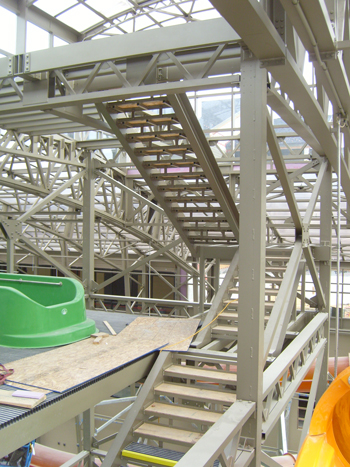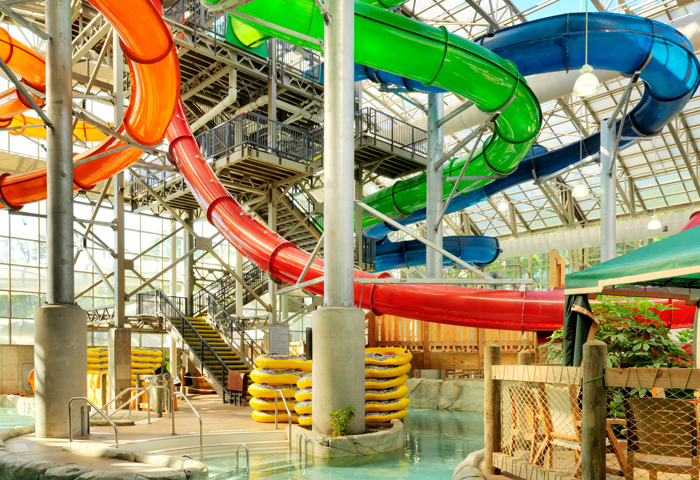By Nancy Patterson
Waterparks, natatoriums, spas, pools—no matter what you call them—are fun places to spend your time! However, these places have a regular visitor that no one appreciates. A visitor that loves every type of venue, every surface, front of house and back of house. That uninvited guest is rust!
Rust, more formally known as oxidation, is the best known of the iron oxide compounds, and occurs in the presence of iron and oxygen combined with water or moisture in the air. It is one of the main unintended consequences of chlorine plus a hot humid environment. It is one of the main the hassles that give aquatic facility owners sleepless nights, and it starts the first day you fill the pool.
As the popularity of indoor aquatic facilities has grown, so too has the trend toward higher water temperatures, increased numbers of guests, and a greater variety and type of water features. Spas now have extra jets and hotter pools, waterparks now have more slides and surfing, standard lane pools now include additional features like splash pads and other accessories. In line with all these “add-ons” is the use of more cleaning products, more maintenance and subsequently more corrosive damage.
The damage that poorly maintained venues can cause both physically and in terms of guest experience can be serious. We have all heard of the worst and most tragic examples of accidents where equipment fails or, even worse, building structures suffer SCC (stress corrosion cracking) failures and people are injured or killed. But the majority of rust issues, while less severe, are far more common and can cause significant long-term damage in other ways. These can include everything from pump room nightmares causing equipment failure to substandard guest amenities and subsequent negative customer reviews to buildings that require renovation or complete closure.

It is clear that both from a guest experience standpoint and from a design one, hot humid environments are unappealing and worse, unhealthy. They are also highly corrosive, and with poor air circulation comes a buildup of chemicals on the building structure in areas that can’t be easily cleaned. Evacuating the air and replacing it with new clean air goes a long way toward helping reduce chloramine deposits.
Most new aquatic facilities include operable windows, doors, skylights and large volumes of sunshine and fresh air—much to the chagrin of mechanical designers who want everyone to keep the doors closed.
With the current cost of energy, operators continue to investigate less costly ways to maintain their venues. One answer for many is natural ventilation, which reduces chloramine deposits in areas that are hard to maintain, like the middle of the waterpark or over the center of a pool. Opening doors, walls and roofs is an easy solution to eliminate chemical-ridden air quickly and as such is an unacknowledged tool in the kit for operators. This plus a well-designed air handling and dehumidification system is the key for every indoor waterpark, both in the front guest space and the back-of-house mechanical rooms.
More often than not, equipment rooms are found in basements or some other adjacent concrete windowless box. The humidity and lack of air flow in these rooms is terrible, we’ve all seen the doors to these spaces propped open with an old chair. We’ve also all seen the rusted piping running though concrete walls to the aquatic area.
The design of air handling for these rooms, the treatment of any metal that touches concrete (a combo that guarantees rust) and the management/control of drips is key to ensuring these spaces don’t become expensive repair areas rather than the control center for your facility.
Another easy solution is care for guest equipment and features. These are things, like ladders, used daily, cleaned daily and are what’s noticed quickly by both staff and guests. Typically keeping the rust under control on guest amenities is a matter of simply using the right cleaning products, the right cleaning equipment and yes, ensuring these items are regularly wet. Items designed using the appropriate materials for the aquatic venue tend to last longest when regularly splashed to remove surface rust.
So what about when you are looking for new equipment or building a new aquatic facility? Can you design to ensure you won’t get rust at all? The short answer is no. But you can pick equipment, amenities and a design that will give your facility the best chance of success, with the right information in hand.
So, what materials incur the least amount of corrosion in an aquatic venue? The easy answer is stainless steel. But not all stainless steel is created equal. While some surface corrosion may be inevitable, and not cause the structural integrity of the item to be harmed, the selection of the right grade of stainless can reduce as much corrosion as possible. This includes not just the material grade, but also the finish applied to it.
Typically stainless is the material of choice for hardware, ladders, any submerged features, drains, etc., because of its excellent corrosion resistance when in direct contact with chlorine water or when submerged in chlorine water. Most common in aquatic venues are types 304 and 316 stainless, which both have excellent corrosion resistance when regularly cleaned and maintained. When used for the structure itself, when load-bearing, those same materials can be at risk of SCC failure when near the ceiling where there is a high probability of accumulating chloramine deposits (and not being cleaned).
For the building structure itself, the challenge for aquatic venues is the need for large-span structures to get across pools, slides or any other interior amenity without columns. As such, metal roofing is typically sought after. However, as noted earlier, steel subject to chloramine buildup can suffer from SCC failure. Stainless steel (the better grade of material we mentioned) is simply too costly to use for such large venues, not to mention the environmental impact of steel production. A new solution for waterparks and aquatic facilities is painted aluminum structures using 6061-T6 grades for main framing and 6063-T6 for things like curtain walls. Painted aluminum structures do not suffer from the same impact of corrosion buildup as steel and as such are a good solution for aquatic venues.
While all indoor aquatic facilities are affected by corrosion, waterparks are particularly susceptible. It is clear that the best antidote to rust is maintenance, including regular daily service of all areas. In addition, preplanning in the design or renovation phase with use of appropriate materials is key to the longevity of every aquatic venue.
When planning your next venture, be sure to avoid anyone who says this is the way we have always done it. Times and access to better performing materials have changed, aquatic venues no longer need to cause sleepless nights! RM
ABOUT THE AUTHOR
Nancy Patterson is the director of design and business development for OpenAire, a Canadian firm that has built retractable roofs and aluminum superstructures for waterparks and aquatic venues for more than 30 years. For more information, visit www.openaire.com.



